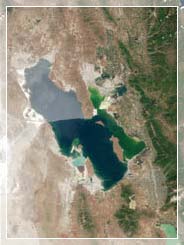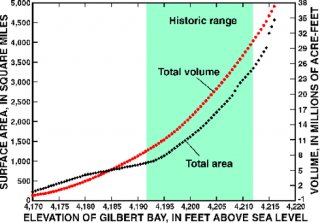![Ecosystem[edit]](http://www.lakekleenerz.org//img/great_salt_lake_wikipedia_the.jpg)
 Area
Area
5, 180 km2 / 2, 000 mi2
Elevation
Minimum: 1, 278 m / 4, 193 ft (1963)
Maximum: 1, 284 m / 4, 212 ft (1987)
Surface: 1, 280 m / 4, 200 ft
Depth
Maximum: 12.2 m / 40 ft
Average: 4.3 m / 14 ft
Great Salt Lake
The Great Salt Lake is the largest remnant of a long succession of older, often more extensive lakes that have existed in the Great Basin for the past 15 million years. The present lake is a shallow body of water with a maximum depth of approximately 35 feet, with its size and depth varying greatly as a result of climate variations. From 1850 to present, the lake has fluctuated in depth more than 20 ft, with the lowest elevation recorded at 4, 191 ft in 1963 and the highest elevation recorded at 4, 212 in 1866 and again in 1986. Because of the shallow nature of the lake, a small rise or fall in water level equates to a large change in surface area covered by water. The variation in depth from 1963 to 1984 resulted in a change in surface area from 1, 686 square miles to 2, 456 square miles, a change of 46 percent. The high water level in the mid-1980s was so damaging to property on the eastern shores of the lake that pumps were installed to move water from the lake to spreading areas in the west desert. The Great Salt Lake and select lands around the lake are sovereign lands of the State of Utah, and there has been considerable debate as to whether the State's property line is the low water mark or the high water mark.
The high water level in the mid-1980s was so damaging to property on the eastern shores of the lake that pumps were installed to move water from the lake to spreading areas in the west desert. The Great Salt Lake and select lands around the lake are sovereign lands of the State of Utah, and there has been considerable debate as to whether the State's property line is the low water mark or the high water mark.
Changes in water level and surface area of the lake are directly tied to changes in precipitation within the watershed, with periods of low water level associated with extended periods of drought and the high level with periods of above average precipitation. This variation relates directly to the quantities of fresh water that fall within the watershed, primarily as snow in the mountains during the winter. The entire watershed is snowmelt runoff driven, with large quantities of fresh water being stored for irrigation in a series of reservoirs located in the mountains above the major urban and agricultural areas of the Wasatch Front.
Source:
 The Great Salt Lake is an ecologically and culturally unique body of water of global significance. Millions of migratory birds annually connect the Great Salt Lake to ecosystems ranging from the high arctic to the wet tropics. Thousands of people visit the lake every year to watch and enjoy the diverse bird life. The lake is also an important economic resource for the state of Utah. It is the source of many minerals with an annual value estimated to be over $230 million in 2000. Brine shrimp harvested form the lake are used for aquiculture and ornamental fish feed and provide a significant portion of the world's supply. The economic value of the brine shrimp harvest ranged from $8 to $32 million during the 1990s. The entire watershed drains directly to the lake, so changes within the watershed affect the lake. Both the mineral and brine shrimp industries are dependent on the concentrations of salts in the lake, which change as the climate changes and as human developments occur.
The Great Salt Lake is an ecologically and culturally unique body of water of global significance. Millions of migratory birds annually connect the Great Salt Lake to ecosystems ranging from the high arctic to the wet tropics. Thousands of people visit the lake every year to watch and enjoy the diverse bird life. The lake is also an important economic resource for the state of Utah. It is the source of many minerals with an annual value estimated to be over $230 million in 2000. Brine shrimp harvested form the lake are used for aquiculture and ornamental fish feed and provide a significant portion of the world's supply. The economic value of the brine shrimp harvest ranged from $8 to $32 million during the 1990s. The entire watershed drains directly to the lake, so changes within the watershed affect the lake. Both the mineral and brine shrimp industries are dependent on the concentrations of salts in the lake, which change as the climate changes and as human developments occur.
Because the lake does not drain to an ocean, it has accumulated salts, minerals, and sediments that have washed from the uplands over centuries of time and those that have been released into the lake by industry, agriculture, and municipal governments since settlement of the region began in 1847. The lake is the largest inland salt water lake in North America, the largest lake in the United States west of the Mississippi river, and the fourth largest terminal lake in the world. The lake is typically three to five times more salty than sea water, and indigenous plants and animals are limited to those that can survive the harsh conditions. Despite these harsh conditions, however, the lake and its associated wetlands complex are an essential stopover for millions of birds as they migrate from their southern winter habitat in the southwestern United States, Central America, and South America to their summer habitat in Canada and Alaska.









